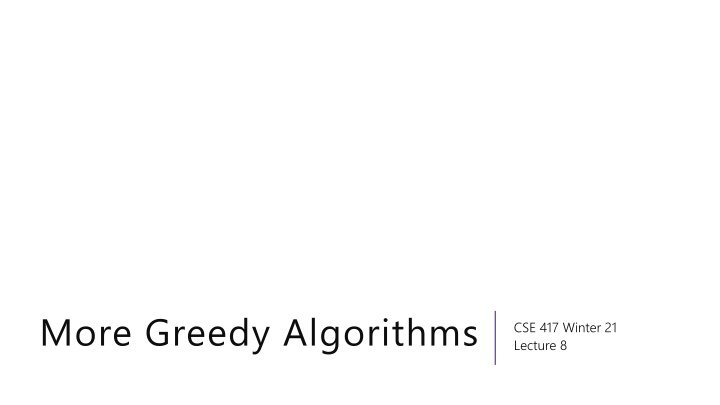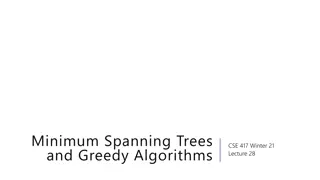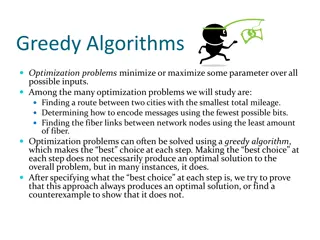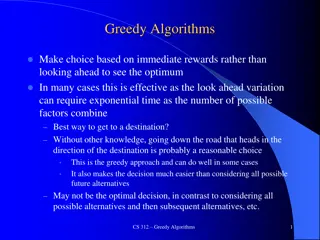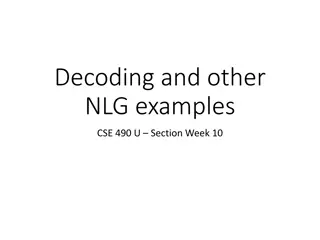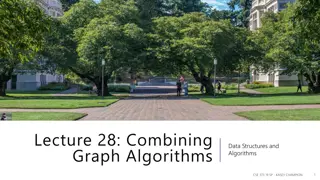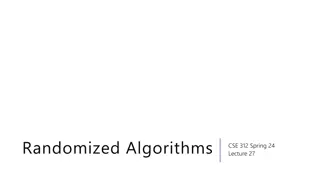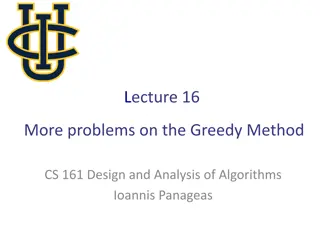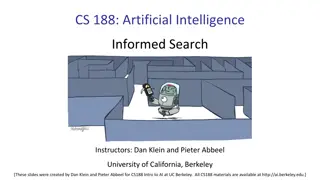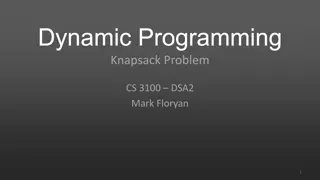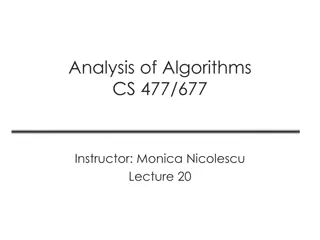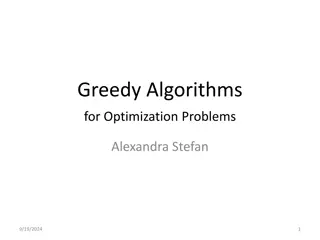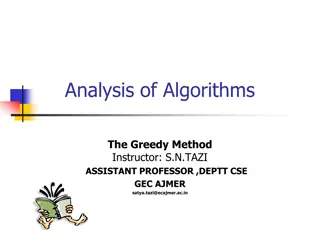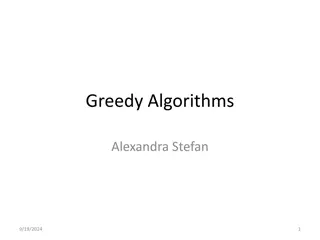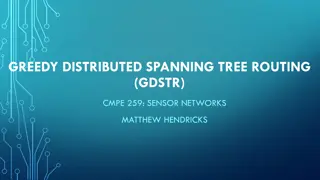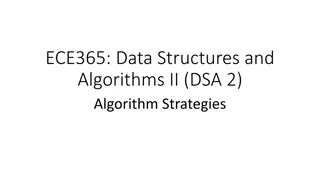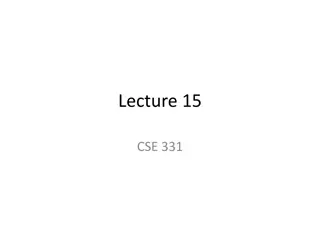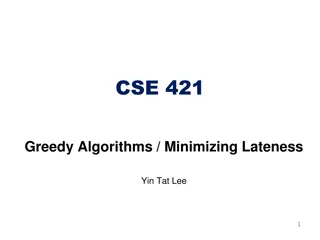More Greedy Algorithms
Trip planning using greedy algorithms for optimal hotel stops along a route from New York to Los Angeles based on driving distance and hotel locations. Understanding the concept of Greedy Stays Ahead in optimizing the number of nights for the trip. Exploring the effectiveness of greedy algorithms in minimizing the number of stops required. Discussing the proof of optimality with inductive reasoning.
Download Presentation

Please find below an Image/Link to download the presentation.
The content on the website is provided AS IS for your information and personal use only. It may not be sold, licensed, or shared on other websites without obtaining consent from the author.If you encounter any issues during the download, it is possible that the publisher has removed the file from their server.
You are allowed to download the files provided on this website for personal or commercial use, subject to the condition that they are used lawfully. All files are the property of their respective owners.
The content on the website is provided AS IS for your information and personal use only. It may not be sold, licensed, or shared on other websites without obtaining consent from the author.
E N D
Presentation Transcript
More Greedy Algorithms CSE 417 Winter 21 Lecture 8
Trip Planning Your goal is to follow a pre-set route from New York to Los Angeles. You can drive 500 miles in a day, but you need to make sure you can stop at a hotel every night (all possibilities premarked on your map) You d like to stop for the fewest number of nights possible what should you plan? Greedy: Go as far as you can every night. Is greedy optimal? Or is there some reason to stop short that might let you go further the next night?
Trip Planning Greedy works! Because greedy stays ahead Let ??be the hotel you stop at on night ? in the greedy algorithm. Let ????be the hotel you stop at in the optimal plan (the fewest nights plan). Claim: ??is always at least as far along as ????. Base Case: ? = 1, OPT and the algorithm choose between the same set of hotels (all at most 500 miles from the start), ??is the farthest of those by the algorithm definition, so ??is at least as far as ????.
Trip Planning Inductive Hypothesis: Suppose through the first ? hotels, ??is farther along than ????. Inductive Step: When we select ??+1, we can choose any hotel within 500 miles of ??, since ??is at least as far along as ????everything less than 500 miles after ????is also less than 500 miles after ??. Since we take the farthest along hotel, ??+1is at least as far along as ????+1. Wrapping up: Since ??is greater than or equal to ????for every ?, The last ??must be at least as far along as ????, so we don t need an extra night compared to ??? the greedy algorithm is optimal!
Other MST Algorithms You know Prim s and Kruskal s already. Option 3: Reverse-Delete algorithm Start from the full graph Sort edges in decreasing decreasing order, delete an edge if it won t disconnect the graph. NOT practical (Prim s and Kruskal s are at least as fast, and conceptually easier), but fun fact!
Other MST Algorithms How would you prove Reverse-Delete works? Structural Proof? Exchange Argument? Greedy Stays Ahead? Fill out the poll everywhere for Activity Credit! Go to pollev.com/cse417 and login with your UW identity
Other MST Algorithms Option 4: Boruvka s Algorithm (also called Sollin s Algorithm) Start with empty graph, use BFS to find lightest edge leaving each component. Add ALL such edges found (they re all safe edges) Recurse until the graph is all one component (i.e. a tree) Consider it for your practical applications! It naturally parallelizes (unlike the other MST algorithms), Has same worst case running time as Prim s/Kruskal s!
Change-Making Suppose you need to make change with the fewest number of coins possible. Greedy algorithm: Take the biggest coin less than the change remaining. Is the greedy algorithm optimal if you have 1 cent coins, 10 cent coins, and 15 cent coins? What about for U.S. coinage (1, 5, 10, 25, 50, 100)
Change-Making Suppose you need to make change with the fewest number of coins possible. Take the biggest coin less than the change remaining. Is the greedy algorithm optimal if you have 1 cent coins, 10 cent coins, and 15 cent coins? What about for U.S. coinage (1, 5, 10, 25, 50, 100) Introduce yourselves! If you can turn your video on, please do. If you can t, please unmute and say hi. If you can t do either, say hi in chat. Choose someone to share screen, showing this pdf. Fill out the poll everywhere for Activity Credit! Go to pollev.com/cse417 and login with your UW identity
Interval Scheduling You have a single processor, and a set of jobs with fixed start and end times. Your goal is to maximize the number of jobs you can process. I.e. choose the maximum number of non-overlapping intervals.
Interval Scheduling You have a single processor, and a set of jobs with fixed start and end times. Your goal is to maximize the number of jobs you can process. I.e. choose the maximum number of non-overlapping intervals. 3 non-overlapping intervals
Interval Scheduling You have a single processor, and a set of jobs with fixed start and end times. Your goal is to maximize the number of jobs you can process. I.e. choose the maximum number of non-overlapping intervals. 3 other non- overlapping intervals
Interval Scheduling You have a single processor, and a set of jobs with fixed start and end times. Your goal is to maximize the number of jobs you can process. I.e. choose the maximum number of non-overlapping intervals. OPT is 3 there is no way to have 4 non-overlapping intervals; both the red and purple solutions are equally good.
Greedy Ideas To specify a greedy algorithm, we need to: Order the elements (intervals) Choose a rule for deciding whether to add. Rule: Rule: Add interval as long as it doesn t overlap with those we ve already selected. What ordering should we use? Think of at least two at least two orderings you think might work.
Greedy Algorithm Some possibilities Earliest end time (add if no overlap with previous selected) Latest end time Earliest start time Latest start time Shortest interval Fewest overlaps (with remaining intervals)
Greedy That list slide is the real difficulty with greedy algorithms. All of those look at least somewhat plausible at first glance. With MSTs that was fine those ideas all worked! It s not fine here. They don t all work. As a first step try to find counter-examples to narrow down
Greedy Algorithm Earliest end time Latest end time Earliest start time Latest start time Shortest interval Fewest overlaps (with remaining intervals)
Take Earliest Start Time Counter Example Algorithm finds Optimum Taking the one with the earliest start time doesn t give us the best answer.
Shortest Interval Algorithm finds Optimum Taking the shortest interval first doesn t give us the best answer
Greedy Algorithm Earliest end time Latest end time Earliest start time Latest start time Shortest interval Fewest overlaps (with remaining intervals)
Earliest End Time Intuition: If ? has the earliest end time, and ? overlaps with ? and ? then ? and ? also overlap. Why? If ? and ?overlap, then both are active at the instant before ? ends (otherwise ? would have an earlier end time). Otherwise ? would have an earlier end time than ?! By the same reasoning, ?is also active the instant before ? ends. So ? and ? also overlap with each other.
Earliest End Time Can you prove it correct? Do you want to use Structural Result Exchange Argument Greedy Stays Ahead
Exchange Argument Let ? = ?1,?2, ,?? be the set of intervals selected by the greedy algorithm, ordered by endtime OPT= ?1,?2, ,? be the maximum set of intervals, ordered by endtime. Our goal will be to exchange to show ? has at least as many elements as OPT. Let ??,?? be the first two elements where ?? and ??aren t the same. Since ?? 1 and ?? 1 are the same, neither ?? nor ?? overlaps with any of ?1, ,?? 1. And by the greedy choice, ?? ends no later than ?? so ??doesn t overlap with ??+1. So we can exchange ?? into OPT, replacing ?? and still have OPT be valid.
Exchange Argument Repeat this argument until we have changed OPT into ?. Can OPT have more elements than ?? No! After repeating the argument, we could change every element of OPT to ?. If OPT had another element, it wouldn t overlap with anything in OPT, and therefore can t overlap with anything in ? after all the swaps. But then the greedy algorithm would have added it to ?. So ? has the same number of elements as OPT does, and we really found an optimal
Greedy Stays Ahead Let ? = ?1,?2, ,?? be the set of intervals selected by the greedy algorithm, ordered by endtime OPT= ?1,?2, ,? be the maximum set of intervals, ordered by endtime. Our goal will be to show that for every ?, ?? ends no later than ??. Proof by induction: Base case: ?1 has the earliest end time of any interval (since there are no other intervals in the set when we consider ?1 we always include it), thus ?1 ends no later then ?1.
Greedy Stays Ahead Inductive Hypothesis: Suppose for all ? ?, ??ends no later than ??. IS: Since (by IH) ?? ends no later than ??, greedy has access to everything that doesn t overlap with ??. Since ?? ends no later than ??, that includes ??+1.Since we take the first one that doesn t overlap, ??+1 will also end before ??+1. Therefore ??+1 ends no later than ??+1 Wrapping Up: Since every ?? ends no later than ??, the last interval greedy selects (??) is no later than ??. There cannot be an ??+1, as if it didn t overlap with ??it also wouldn t overlap with ?? and would have been added by greedy.
Greedy Algorithm Earliest end time Latest end time Earliest start time Latest start time Shortest interval Fewest overlaps (with remaining intervals)
Other Greedy Algorithms It turns out latest start time and fewest overlaps also work. Latest start time is actually the same as earliest end time (imagine reflecting all the jobs along the time axis the one with the earliest end time ends up having the last start time). What about fewest overlaps? Easiest proof Robbie knows observes that fewest overlaps means you have the earliest finish time (among a certain subset of the intervals)
Greedy Algorithm Earliest end time Latest end time Earliest start time Latest start time Shortest interval Fewest overlaps (with remaining intervals)
Summary Greedy algorithms You ll probably have 2 (or 3 or 6) ideas for greedy algorithms. Check some simple examples before you implement! Greedy algorithms rarely work. When they work AND you can prove they work, they re great! Proofs are often tricky Structural results Structural results are the hardest to come up with, but the most versatile. Greedy stays ahead Greedy stays ahead usually use induction Exchange Exchange start with the first first difference between greedy and optimal.
